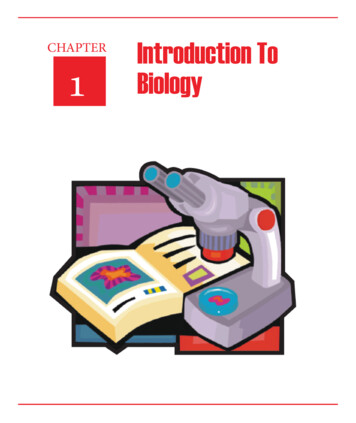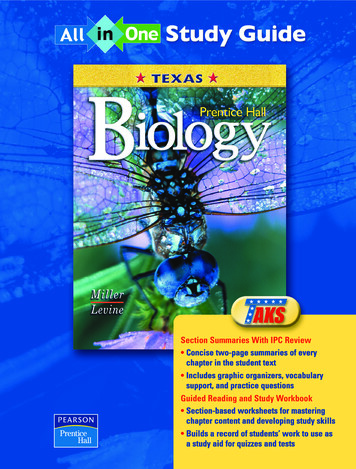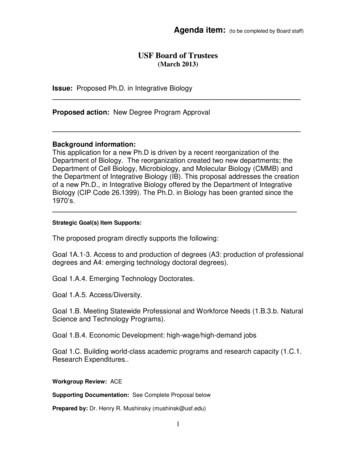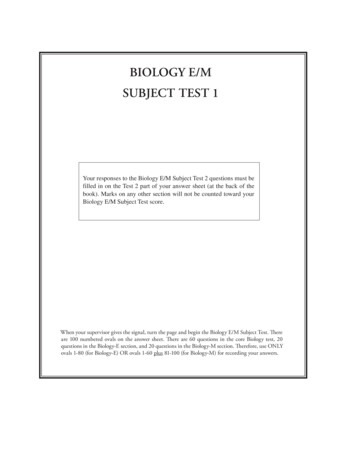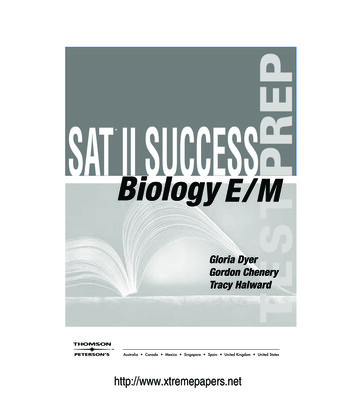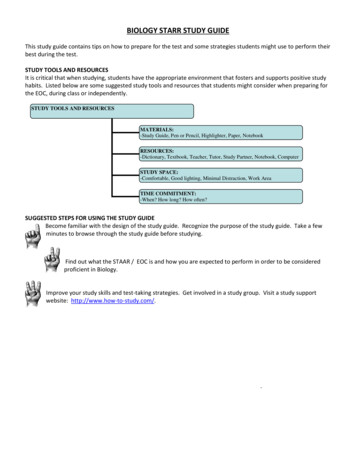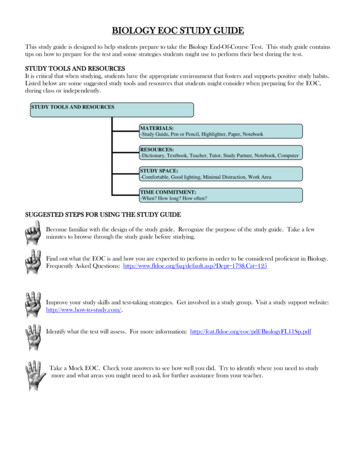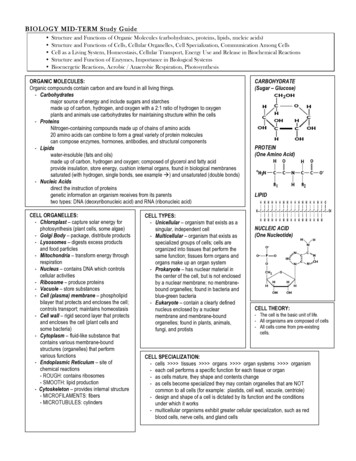
Transcription
BIO LO GY M ID-TERM Study Guide Structure and Functions of Organic Molecules (carbohydrates, proteins, lipids, nucleic acids)Structure and Functions of Cells, Cellular Organelles, Cell Specialization, Communication Among CellsCell as a Living System, Homeostasis, Cellular Transport, Energy Use and Release in Biochemical ReactionsStructure and Function of Enzymes, Importance in Biological SystemsBioenergetic Reactions, Aerobic / Anaerobic Respiration, PhotosynthesisORGANIC MOLECULES:Organic compounds contain carbon and are found in all living things.- Carbohydratesmajor source of energy and include sugars and starchesmade up of carbon, hydrogen, and oxygen with a 2:1 ratio of hydrogen to oxygenplants and animals use carbohydrates for maintaining structure within the cells- ProteinsNitrogen-containing compounds made up of chains of amino acids20 amino acids can combine to form a great variety of protein moleculescan compose enzymes, hormones, antibodies, and structural components- Lipidswater-insoluble (fats and oils)made up of carbon, hydrogen and oxygen; composed of glycerol and fatty acidprovide insulation, store energy, cushion internal organs, found in biological membranessaturated (with hydrogen, single bonds, see example à ) and unsaturated (double bonds)- Nucleic Acidsdirect the instruction of proteinsgenetic information an organism receives from its parentstwo types: DNA (deoxyribonucleic acid) and RNA (ribonucleic acid)CELL ORGANELLES:- Chloroplast – capture solar energy forphotosynthesis (plant cells, some algae)- Golgi Body – package, distribute products- Lysosomes – digests excess productsand food particles- Mitochondria – transform energy throughrespiration- Nucleus – contains DNA which controlscellular activities- Ribosome – produce proteins- Vacuole – store substances- Cell (plasma) membrane – phospholipidbilayer that protects and encloses the cell;controls transport; maintains homeostasis- Cell wall – rigid second layer that protectsand encloses the cell (plant cells andsome bacteria)- Cytoplasm – fluid-like substance thatcontains various membrane-boundstructures (organelles) that performvarious functions- Endoplasmic Reticulum – site ofchemical reactions- ROUGH: contains ribosomes- SMOOTH: lipid production- Cytoskeleton – provides internal structure- MICROFILAMENTS: fibers- MICROTUBULES: cylindersCELL TYPES:- Unicellular – organism that exists as asingular, independent cell- Multicellular – organism that exists asspecialized groups of cells; cells areorganized into tissues that perform thesame function; tissues form organs andorgans make up an organ system- Prokaryote – has nuclear material inthe center of the cell, but is not enclosedby a nuclear membrane; no membranebound organelles; found in bacteria andblue-green bacteria- Eukaryote – contain a clearly definednucleus enclosed by a nuclearmembrane and membrane-boundorganelles; found in plants, animals,fungi, and protistsCARBOHYDRATE(Sugar – Glucose)PROTEIN(One Amino Acid)LIPIDNUCLEIC ACID(One Nucleotide)CELL THEORY:- The cell is the basic unit of life.- All organisms are composed of cells- All cells come from pre-existingcells.CELL SPECIALIZATION:- cells tissues organs organ systems organism- each cell performs a specific function for each tissue or organ- as cells mature, they shape and contents change- as cells become specialized they may contain organelles that are NOTcommon to all cells (for example: plastids, cell wall, vacuole, centriole)- design and shape of a cell is dictated by its function and the conditionsunder which it works- multicellular organisms exhibit greater cellular specialization, such as redblood cells, nerve cells, and gland cells
CELL TRANSPORT:- Passive Transport – movement of substances across the plasma membrane without the use of the cell’s energy (with the concentration gradient)1. DIFFUSION – movement of substances across the plasma membrane from an area of high concentration to an area of low concentration2. OSMOSIS – diffusion of water across the plasma membrane from areas of high concentration to areas of lower concentration3. FACILITATED TRANSPORT – a carrier molecule embedded in the plasma membrane transports a substance across the plasma membrane followingthe high-to-low concentration gradient- Active Transport – movement of substances across the plasma membrane that requires the use of the cell’s energy and carrier molecules; substancesare moving from an area of low concentration to an area of higher concentration (against the concentration gradient)1. ENDOCYTOSIS – large particles are brought into the cell2. EXOCYTOSIS – large particles leave the cell- HOMEOSTASIS – internal equilibrium; the plasma membrane regulates what enters and leaves the cell; a selectively permeable membrane only allowscertain substances to pass through- Effect of Concentration on a Cell1. HYPOTONIC – water moves in; cell bursts2. HYPERTONIC – water moves out; cell shrivels3. ISOTONIC – no net movement; cell maintains equilibriumHOMEOSTASIS: Self-regulating mechanism that maintains internal conditions (with individual cells and within organs, systems) Example: body temperature,respiration, nutritional balance, etc. Cells communicate their needs to each other mainly through their cell membranes by releasing chemical messengersthat, ultimately, tell the hypothalamus gland in the brain that a change needs to be made in the interstitial fluid. Since it is the ruler of homeostasis, thehypothalamus sends neural and chemical signals to other glands, tissues, organs, and organ systems to adjust the internal environment, the interstitial fluid,so that it is more suitable for all the cells at that particular time. And since we are always changing what we are doing, homeostasis needs to change alongwith our activities, both day and night. This constantly changing internal environment is the process of homeostasis.Negative Feedback: Glucose / Insulin levels in cellsPositive Feedback: Blood platelets / Blood clottingBIOCHEMICAL REACTIONS: chemical bonds are formed and broken within living things creating chemical reactions that impact the ability to maintainlife and carry out life functionsCellular Respiration – food molecules are converted to energy; there are three stages to cellular respiration; the first stage is calledglycolysis and is anaerobic (no oxygen is required); the next two stages are called the citric acid cycle and the electron transport chain andare aerobic (oxygen is required)C6H12O6 6O2 6CO2 6H2O ENERGY (36 ATP)Photosynthesis – plant cells capture energy from the Sun and convert it into food (carbohydrates); plant cells then convert thecarbohydrates into energy during cellular respiration; the ultimate source of energy for all living things is the Sun (in Chemosynthesis,organisms use sulfur or nitrogen as the main energy source)6CO2 6H2O ENERGY(from sunlight) C6H12O6 6O2ATP – ATP is a molecule that stores and releases the energy in its bonds when the cell needs it; removing a phosphate group (P) releasesenergy for chemical reactions to occur in the cell and ATP becomes ADP; when the cell has energy, the energy is stored in the bond whenthe phosphate group is added to the ADPATP ADP P ENERGYFermentation – when cells are not provided with oxygen in a timely manner, this process occurs to continue producing ATP until oxygen isavailable again; glucose is broken down; there are two types of fermentationLactic Acid Fermentation (muscle cells)Glucose Lactic Acid 2ATPAlcoholic Fermentation (plant cells)Glucose CO2 Alcohol 2ATP
AEROBIC AND ANAEROBIC RESPIRATION:Aerobic Respiration –requires the presence of oxygenrelease of energy from the breakdown of glucose (or another organic compound) in the presence of oxygenenergy released is used to make ATP, which provides energy for bodily processestakes place in almost all living thingsAnaerobic Respiration –occurs in the absence of oxygenbreakdown of food substances in the absence of oxygen with the production of a small amount of energyproduces less energy than aerobic respirationoften called fermentationseen as an adaptation for organisms that live in environments that lack oxygenCOMPARISON OF CELLULAR RESPIRATION, PHOTOSYNTHESIS AND CHEMOSYNTHESISCELLULAR RESPIRATIONPHOTOSYNTHESISCHEMOSYNTHESISFood Broken DownFood SynthesizedFood SynthesizedEnergy from Glucose ReleasedEnergy from Sun stored in GlucoseEnergy from Methane or Inorganic MaterialCarbon Dioxide given offCarbon Dioxide taken in(ex: H gas or Hydrogen sulfide)Oxygen taken inOxygen given offOrganisms often called chemotrophsProduces Carbon Dioxide and WaterProduces Sugars (Glucose) from PGALOrganisms called extremophilesDoes not require LightRequires LightLive in environments without oxygenOccurs in ALL Living CellsOccurs only in presence of ChlorophyllAnaerobic BacteriaOrganisms often called HeterotrophsOrganisms called AutotrophsHabitats: hydrothermal ventsENZYMES:Enzymes are special proteins that regulate nearly every biochemical reaction in the cell. Different reactions require different enzymes.Enzymes function to:Provide energy to cellsBuild new cellsAid in digestionBreak down complex molecules (“substrate” reactant)Catalysts (speed up chemical reactions without being used up or altered)Factors that affect enzymes: pH, temperature, and quantity
DNA Molecular Basis of Heredity, DNA Replication, Protein Synthesis (Transcription, Translation), Gene Regulation Characteristics of Sexual and Asexual Reproduction Patterns of Inheritance, Dominant / Recessive / Intermediate Traits, Multiple Alleles, Polygenic Inheritance, Sex-LinkedTraits, Independent Assortment, Test Cross, Pedigrees, Punnett Squares Impact of Advances in Genomics on Individuals and Society, Human Genome Project, Applications of BiotechnologyDNA & RNA:- Nucleic acids composed of nucleotides- Nucleotides composed of:Phosphate groupSugarNitrogenous baseCOMPARISON OF DNA AND RNADNARNADeoxyribonucleic acidDouble-stranded, twisted helixNever leaves the nucleusNitrogenous bases: adenine, thymine, guanine, cytosine(Guanine w/Cytosine, Adenine w/Thymine)(Purines opposite the Pyrimidines)(held together by weak hydrogen bonds)Sugar: deoxyriboseControls production of all proteinsDNA Replication:(DNA unravels and each strand makes a new exact copy so that whenmitosis takes place, each cell has the exact copy of DNA)DNA coiled into chromosomes in nucleusTiny sections of DNA are called genesSequence of bases determines sequence of amino acids in proteinsRibonucleic acidSingle-strandedLeaves the nucleusNitrogenous bases: adenine, uracil, guanine, cytosine(Guanine w/Cytosine, Adenine w/Uracil)Sugar: riboseThree major types of RNA(Ribosomal – rRNA; Messenger – mRNA; Transfer – tRNA)Leaves the nucleus to carry out functions in cytoplasmTranscription:(mRNA is made from one strand of DNA, carries message to ribosomes)Translation:(mRNA translated into a protein at the ribosomes; tRNA transfers amino acidsfrom cytoplasm to ribosomes)Protein Synthesis:Transcription andTranslation
Asexual and Sexual Reproduction:Asexual Reproduction – a single parent produces one or more identical offspring by dividing into two cells - mitosis (protists, arthropods,bacteria by binary fission, fungi, plants); produces large numbers of offspring- offspring are clones of parents (genetically identical)- common in unicellular organisms, good for stable environments- budding, binary fission, conjugation- quick process (low energy requirement) – produces high number of offspringSexual Reproduction – pattern of reproduction that involves the production and fusion of haploid sex cells; haploid sperm from fatherfertilizes haploid egg from mother to make a diploid zygote that develops into a multicellular organism through mitosis- results in genetic variation (diversity)- common in multicellular organisms (external or internal fertilization); good for changing environments- slow process (high energy requirement) – produces low number of offspring- meiosis formation of sex cells (gametes)CELL DIVISION:process of copying and dividing the entire cellthe cell grows, prepares for division, and then divides to form new daughter cellsallows unicellular organisms to duplicate in a process called asexual reproductionallows multicellular organisms to grow, develop from a single cell into a multicellular organism, make other cells to repair and replaceworn out cellsthree types: binary fission (bacteria and fungi), mitosis, and meiosisCOMPARISON OF MITOSIS AND MEIOSISMITOSISMEIOSISCell cycle consists of interphase, mitosis, and cytokinesisConsists of two cell divisions, but only one chromosome replicationInterphase – longest part of cell cycle(sometimes called reduction division)Growth, metabolism, and preparation for division occursEach cell division consists of prophase, metaphase, anaphase, andDuplicates chromosomes (DNA Replication)telophaseMitosis – division of nucleus of the cellOccurs only in sex cells – to produce more sex cells (gametes)Prophase - duplicated chromosomes and spindle fibersFirst Meiosis DivisionappearProduces cells containing ½ # of double stranded chromosomesMetaphase – duplicated chromosomes line up randomlySecond Meiosis Divisionin center of cell between spindle fibersResults in formation of four cellsAnaphase – duplicated chromosomes pulled to oppositeEach cell w/ ½ # of single-stranded chromosomesends of cell(haploid cells)Telophase – nuclear membrane forms ---------------------------------------chromosomes at each end of cell; spindle fibersSpermdisappear; chromosomes disperseEach primary sperm cell develops into four haploid cells of equal size. AsCytokinesis – division of plasma membrane; two daughter cellscells mature, the cells lose most of their cytoplasm and develop a longresult with exact genetic informationwhip-like tail for movement.(in plant cells a “cell plate” forms along the center of the cell andEggcuts the cell in half; cell plate forms new cell walls once the plasmaEach primary egg cell develops into one large haploid cell and threemembrane divides)smaller haploid cells called polar bodies. The first meiosis divisionRESULTS:produces one large cell and one polar body. The second meiosis causesTwo daughter cells (body cells)the large cell to produce one egg cell and a polar body; the originalSame number of chromosomes as original cell (humans 46)smaller polar body divides into two polar bodies. The polar bodiesCells are diploid (human diploid # 46 or 23 homologous pairs)eventually disintegrate. The final egg cell is provided with the largersupply of stored nutrientsRESULTS:Four daughter cells (sex cells)½ # of chromosomes (haploid) with genetic variation (n 23)Sex cells combine during sexual reproduction to produce a diploidindividual
GENETICS:– branch of biology that deals with heredity– Gregor Mendel experimented with sweet peaplants in 1800s– Trait – characteristic an individual receives fromits parents– Gene – carries instructions responsible forexpression of traits; a pair of inherited genescontrols a trait; one member of the pair comesfrom each parent; often called alleles– Homozygous – two alleles of a pair are identical(BB or bb)– Heterozygous – two alleles of a pair aredifferent (Bb); often called “hybrid”– Dominant – controlling allele; designated with acapital letter– Recessive – hidden allele; designated withlower-case letters– Genotype – genetic makeup of an organism(represented by the letters)– Phenotype – physical appearance of anorganism (description of the letters)– Monohybrid – cross involving one trait– Dihybrid – cross involving two traits– Punnett Square – graphic organizer used toshow the probable results of a genetic cross– Pedigree – graphic organizer to map genetictraits between generations– Karyotype – chart of metaphase chromosomepairs to study chromosome number /diseases– Test Cross – mating of an individual of unknowngenotype with an individual of knowngenotype; can help to determine the unknowngenotype of the parentMENDELS LAWS OF HEREDITY:1. Law of Dominance- the dominant allele will prevent therecessive allele from beingexpressed- recessive allele will appear when itis paired with another recessiveallele in the offspring2. Law of Segregation- gene pairs separate when gametes(sex cells) are formed- each gamete has only one allele ofeach gene pair3. Law of IndependentAssortment- different pairs of genes separateindependently of each other whengametes are formed (Anaphase II inMeiosis)PATTERNS OF INHERITANCE:Sex Chromosomes- 23rd pair of chromosomes; Males XY; Females XXSex-Linked Traits- traits associated with particular sexes- X-Linked Traits inherited on X chromosome from mother (ex: colorblindness, baldness, hemophilia)Linked Traits- genes are linked on chromosomes; genes on same chromosome are inherited together; ex: red hair and freckles- one trait controlled by many genes (ex: hair color, eye color, skin pigment)Multiple Alleles- presence of more than two alleles for a trait (ex: eye color)Polygenic Inheritance- one trait controlled by many genes (ex: hair color, skin color); genes may be on the same or different chromosomesCodominance- phenotypes of both homozygous parents are produced in heterozygous offspring so that both alleles are equally expressed (ex:black chicken white chicken checkered chickens), (ex: sickle cell anemia)Incomplete Dominance- phenotype of a heterozygote is intermediate between the two homozygous parents; neither allele is dominant, but combine todisplay a new trait (ex: red flower white flower pink flower)Dominance / Recessive ness- observed trait is controlled by a homozygous genotype- ex: dominance disease – Huntington’s; ex: recessive disease – Cystic Fibrosis and Tay Sach’sSOURCES OF VARIATION:Crossing Over- genes from one chromosome are exchanged with genes from another chromosome- occurs regularly during meiosis and leads to greater genetic variation- many different phenotypes are a result of the random assortment of genes that occurs during sexual reproductionNondisjunction- during meiosis, homologous pairs of chromosomes don’t separate- results in half the sex cells having an extra chromosome and the other half having one less chromosome- if fertilization occurs with an abnormal sex cell, zygote formed will have either one extra (trisomy) or one less (monosomy) thanthe diploid number (ex: Down’s Syndrome caused by extra 21st chromosome)Genetic Variation- influenced by crossing over, mutations, genetic engineering, random assortment of genes, natural selection- genetic variation controlled by sexual reproduction (does not occur in asexual reproduction)- gene regulation vs. gene expression – the expression of genes is regulated by turning genes on / off or amount of action- environment can influence magnitude of gene expression (ex: improper nutrition can prevent proper bone growth)
GENETIC ENGINEERING (GENOMICS):- sometimes called biotechnology- process of transferring a gene (DNA) from one organism to another- Organisms with transferred gene now produce “recombined” genetic code ( called “recombinant DNA”)- Ex: insulin produced through bacteria- Ex: oil-eating bacteria- Has application in medicine, environment, industry, agriculture, selective breeding- Human Genome Project- DNA FingerprintingKARYOTYPE: to identify gender or chromosomal abnormalitiesPEDIGREEPUNNETT SQUARESCIENCE, PSEUDOCIENCE & NON SCIENCEscience encompasses all the observable, verifiable knowledge of the human race.non-science either encompasses subjective knowledge (such as history, phylosophy, economics, which, although it's notscience, it isn't junk either)pseudoscience (junk science) are myths and beliefs that pose as observable and verifiable facts in order to further an agenda(ex. astrology, psychic readings)
PLANT CELL TYPESParenchyma Cells- Least specialized plant cells- Thin and somewhat flexible cell walls- Living at maturity- Carry on most of the plant's metabolic functions- Generally have a large central vacuole- Most parenchyma cells have the ability to differentiate into other cell types under special conditions ex. during repairand replacement of organs after injuryCollenchyma Cells- Thicker primary cells walls (usually with uneven thickness)- Living at maturity- Role in support of herbaceous plants. Example - the "strings" of celerySchlerenchyma Cells· Thick secondary cell walls· Dead at functional maturity· Cannot increase in length - occur in parts of the plant which have quit growing in lengthXylem· Thick secondary cell walls, often deposited unevenly in a coil-like pattern so that they may stretch· Dead at functionally maturity.· Involved in conduct of water and ions in the plantPhloemInvolved in transport of sucrose, other organic compounds, and some ionsLiving at functional maturityEndwalls connect to each other via sieve-platesTwo types of cells in the phloem - sieve-tube members and companion cellsSieve-tube members - actual conduit for sucrose transportCompanion cells - has a nucleus that may also control the sieve-tube element and may aid in sucroseloadingANGIOSPERMS (Flowering Plants)PLANT GROWTH- The plant retains areas where rapidly dividing, undifferentiated cells remain all through the life of the plant .These areas are called meristems- Meristematic tissue continues to rapidly divide producing undifferentiated cells which may eventuallydifferentiate to form the tissue and cell types discussed above- Plants do not have a pre-programmed body planThere are constants like leaf shape and branching patters (opposite, alternate, etc.) but you can neverpredict where a new branch will come about on a tree.Plants continue to grow throughout their lifeMeristems- pattern of plant growth depends upon the location of meristemsApical Meristems- located at the tips of roots and shoots- supply cells for the plant to increase in length (grow up for shoots and down for roots)- growth in this direction is known as primary growthprimary growth found in herbaceous and woody plantsprimary growth found in monocots and dicotsLateral Meristem- located near the periphery of the plant, usually in a cylinder- supply cells for the plant to increase in girthAnther - structure that contains pollengrowth in this direction is known as secondary growthFilament - stalk that supports the antherfound in all woody and some herbaceous plantsStigma - sticky top surface of the pistillateral meristems and secondary growth found only in dicotsStyle - tube part of the pistil between the stigma and the ovaryOvary - part of the pistil that contains ovules, turns into fruit after fertilizationTISSUE ORGANIZATION IN ANGIOSPERMSOvules -structures in the ovary that contain egg cells, develop into seeds once fertilizedDermal TissueSepal - small leaves at base that protects the flower before it blooms- Generally a single layer of cellsPetals - brightly colored part of the flower that attracts insects- The "skin" of the plantPollen Tube - tube that grows from a pollen grain to an ovule- Primarily parenchyma cellsPollen - tiny grains that contain sperm cells- Main role is protection of the plantGround Tissue- Makes up the bulk of the plant- Predominately parenchyma, but collenchyma and schlerenchyma cells are found- Diverse functions including photosynthesis, storage, and supportVascular Tissue- Involved in the transport of water, ions, minerals, and food- Also has a secondary role in support- Composed of xylem, phloem, parenchyma, schlerenchyma
Asexual and Sexual Reproduction: Asexual Reproduction - a single parent produces one or more identical offspring by dividing into two cells - mitosis (protists, arthropods, bacteria by binary fission, fungi, plants); produces large numbers of offspring - offspring are clones of parents (genetically identical)

